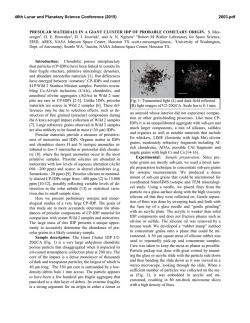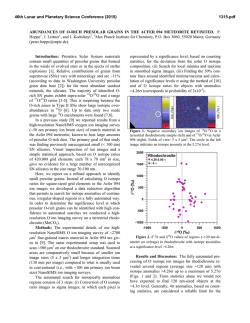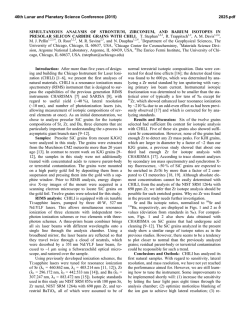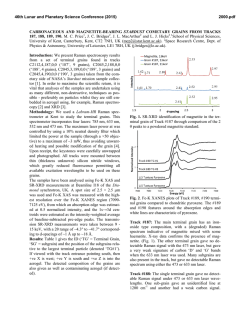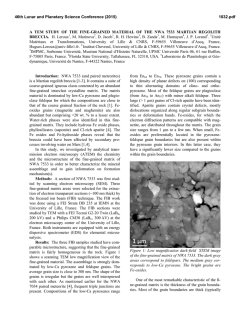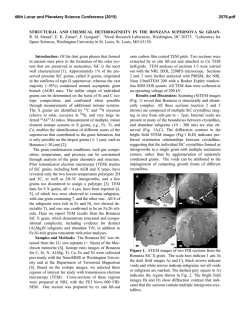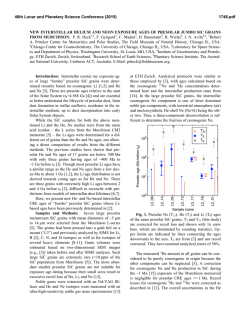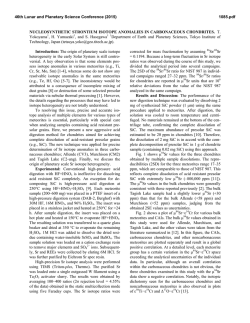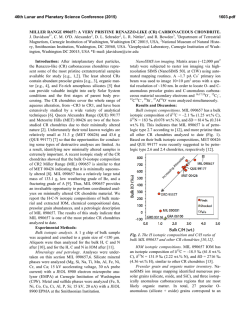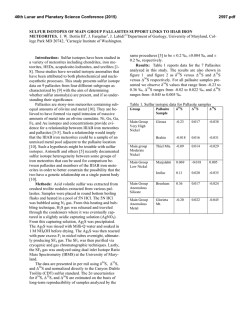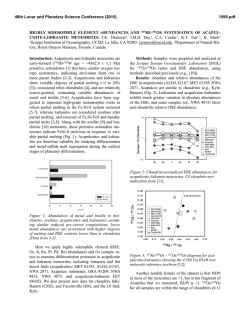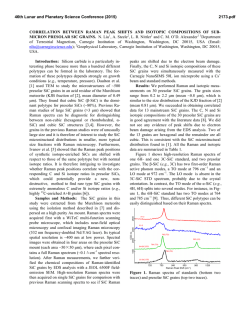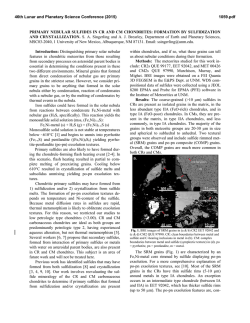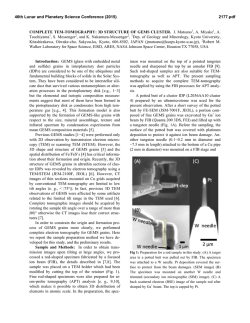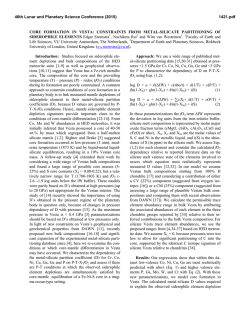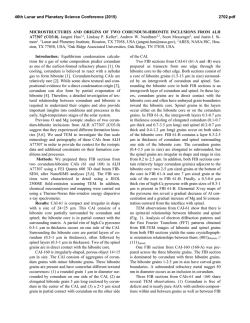
IDENTIFCATION OF CIRCUMSTELLAR MAGNETITE IN THE LAPAZ
46th Lunar and Planetary Science Conference (2015) 2828.pdf IDENTIFCATION OF CIRCUMSTELLAR MAGNETITE IN THE LAPAZ ICEFIELD 031117 CO3.0 CHONDRITE. T. J. Zega1, P. Haenecour2,3, C. Floss2,4, and R. M. Stroud5. 1Lunar and Planetary Laboratory, University of Arizona, Tucson, AZ 85721, USA. 2Laboratory for Space Sciences, 3Dept. of Earth and Planetary Sciences, 4Physics Department, Washington University, St. Louis, MO 63130, USA. 5Code 6366, Naval Research Laboratory, 4555 Overlook Avenue, Washington DC 20375. ([email protected]). Introduction: Refractory dust grains formed in ancient stars were injected into our solar system over 4.5 billion years ago. Such presolar circumstellar materials were incorporated into primitive meteorites, and locked up within their crystal chemistry and structure are snapshots of the state of the stars when the circumstellar grains condensed. Probing these materials can provide ground-truth information on nucleosynthetic processes that occurred in their parent stars, the thermodynamics that took place in the circumstellar envelopes from which they condensed, transport and irradiation processes within the interstellar medium, and secondary processes that could have affected them during solar system evolution. Oxide grains are among the varied presolar phases that have been identified in primitive meteorites [1]. Calculations predict oxide formation in the outflows of AGB stars and in the condensation sequence of our solar system [e.g., 2-4]. It has been suggested that oxide dust grains such as corundum and/or spinel may be responsible for the 13 µm emission feature of IR spectra of O-rich AGB stars [5-8], and comparison of remotely sensed infrared and laboratory-based spectra suggests that the oxide hibonite (CaAl12O19) may occur in planetary nebulae [9]. Previously we have reported on the microstructural properties of hibonite and spinel [10, 11]. Here we report on the first microstructural confirmation of presolar circumstellar magnetite (Fe3O4). Samples and Experimental Methods: A petrographic thin section of the LaPaz Icefield 031117 (LAP 031117) CO3.0 chondrite was examined with the Washington University NanoSIMS 50 to search for presolar grains (e.g., silicates, oxides, and SiC). C- and O-raster ion imaging was carried out on fine-grained matrix areas of the meteorite, following standard procedures [12]. From among the O-rich presolar grains identified by [13, 14], we selected grain LAP-103 measuring ~550 ! 700 nm, for detailed structural and chemical analysis. We used the Auger Nanoprobe at Washington University to acquire elemental distribution maps of the grain. We prepared an electron-transparent cross section of the grain with an FEI Nova 200 focused-ionbeam scanning-electron microscope (FIB-SEM) located at Arizona State University using previously described methods [15]. The FIB section was examined using a 200 keV JEOL 2000FS transmission electron microscope (TEM) at the Naval Research Laboratory (Washington, DC). The 2200FS is equipped with an energydispersive X-ray spectrometer (EDS) and bright-field and dark-field scanning TEM (STEM) detectors. The grain composition was quantified from a spectrum image acquired using a ThermoElectron Si(Li) EDS detector. Grain structure was determined using selected-area electron-diffraction (SAED) patterns. Results: NanoSIMS shows that grain LAP-103 has 17O/16O = (35.5 ± 0.6) x 10-4; 18O/16O = (2.05 ± 0.04) x 10-3, which places it within the Group 1 field, as originally defined by [16]. Auger elemental distribution maps indicate that grain LAP-103 consists only of Fe and O. TEM imaging shows the localized area corresponding to O-isotopic anomaly LAP-103 contains a triangular-shaped grain, with subhedral to anhedral morphology, measuring approximately 750 nm ! 670 nm in orthogonal dimensions (Fig. 1). SAED patterns acquired across LAP-103 show that it is a single crystal (Fig. 1) and measurements of the patterns are consistent with and indexed to the magnetite spinel structure. X-ray spectrum imaging shows that the grain contains only Fe and O and quantification gives stoichiometric Fe3O4 (42.86±0.29 at% Fe; 57.14 at% O), corroborating the SAED data. LAP-103 is surrounded by coarse (µm-sized) grains and resides on top of a locally porous network composed mostly of nanocrystalline Mg silicates. The grain does not show any obvious sign of surface amorphization or alteration rims, and appears to be free of defects. Discussion: Comparison of the O isotopic composition of LAP-103 with stellar models suggests that it condensed from an RGB star undergoing first dredgeup whose initial mass was approximately 2.2M! with a solar metallicity. The TEM data identify LAP-103 as a single crystal of magnetite. Both single-crystal and polycrystalline presolar oxide grains have been previously observed. For example, [17] reported on two Al2O3 grains that condensed in the circumstellar envelope(s) around AGB stars. In comparison, [10] reported on five presolar hibonite (CaAl12O19) grains, four of which condensed in the circumstellar environments around RGB/AGB stars and one that condensed in the ejecta of a Type II supernova. In a separate study, [11] reported on the microstructural properties of four presolar spinel grains whose isotopic compositions indicate origins in low-mass O-rich AGB stars. The LAP- 46th Lunar and Planetary Science Conference (2015) 103 magnetite grain reported herein seems to be generally consistent with the trend so far observed for presolar oxides, i.e., it is a stoichiometric single crystal. However, the origin of magnetite, so far as we understand it from the meteoritic record, is somewhat controversial. Magnetite has been previously identified in CO3.0 chondrites such as ALHA77307 [24] and other chondritic meteorites that span petrologic types 1 through 3 [18-22]. It exhibits a range of morphologies including plaquettes, framboids, stacked platelets, spherules, and trapezohedral grains [e.g., 18, 20, 23]. Such morphologies likely reflect the different modes ascribed to its origin, which include condensation in the solar nebula [22, 24], gas-solid reaction of pre-existing material (e.g., Fe metal or perovskite) in the solar nebula [20, 25], and aqueous-phase reactions on the parent asteroidal bodies of meteorites [21, 23, 26-28]. We find no evidence of hydration in this FIB section, such as the presence of sheet silicates or carbonates, which might otherwise suggest the possibility that secondary alteration on the parent body could have led to the formation of grain LAP-103. We infer, therefore, that the homogeneous composition and the lack of evidence for secondary alteration suggest that the magnetite retained the structural and chemical properties it acquired during condensation in the CSE of its progenitor star. That the magnetite condensed in a solar-metallicity star and is stoichiometric, we assume that equilibrium calculations, which model a condensing gas of solar composition, should be applicable. However, such calculations do not predict that magnetite will condense from the gas phase under canonical nebular conditions [2, 4, 29, 30], as Fe in the gas prefers to condense into metal. An alternative pathway for magnetite formation is the oxidation of preexisting metal grains. The kinetics of this reaction and its astrophysical implications will be discussed at the meeting. References: [1] Zinner, E.K. (2014), Presolar grains, in Meteorites, comets, and planets, 181-213. [2] Ebel D.S. and Grossman L. (2000) GCA, 64, 339-366. [3] Gail H.-P. and Sedylmayr E. (1999) A&A, 347, 594-616. [4] Lodders K. (2003) ApJ, 591, 1220-1247. [5] Kozasa T. and Sogawa H. (1997) Astro. & Space Sci., 251, 165-170. [6] Onaka T. et al. (1989) A&A, 218, 169-179. [7] Posch T. et al. (1999) A&A, 352, 609-618. [8] Speck A.K. et al. (2000) A&A Supp. 146, 437-464. [9] Hofmeister A.M. et al. (2004) GCA 68, 44854503. [10] Zega T.J. (2011) ApJ, 730, 83-93. [11] Zega T.J. et al. (2014) GCA, 124, 152-169. [12] Floss C. and Stadermann F. (2009) GCA, 73, 2415-2440. [13] Haenceour P. and Floss C. (2012) LPSC, Abstract #1107. [14] Haenceour P. and Floss C. (2013) LPSC, Abstract #1024. [15] Zega T.J. et al. (2007) M&PS, 42, 1373-1386. [16] Nittler L.R. (1997) Presolar oxide grains in meteorites, AIP: New York, 59-82. [17] Stroud R.M. et al. (2004) Science, 2828.pdf 305, 1455-1457. [18] Hyman M. et al. (1985) JGR, 90, c710c714. [19] Jedwab J. (1967) EPSL, 2, 440-444. [20] Kerridge J.F. (1970) EPSL, 9, 299-306. [21] Kerridge J.F. et al. (1979) Science, 205, 395-397. [22] Nagahara H. (1984) GCA, 48, 2581-2595. [23] Hua X. and Buseck P.R. (1998) M&PS, 33, A215-A220. [24] Brearley A.J. (1993) GCA, 57, 1521-1550. [25] Kurat G.E. et al. (2002) GCA, 66, 2959-2979. [26] Bullock E.S. et al. (2005) GCA, 69, 2687-2700. [27] Choi B.G. et al. (1997) EPSL, 146, 337-349. [28] Krot A.N. et al. (1997) GCA, 61, 219-237. [29] Ebel D.S. (2006) MESS II, 253-277. [30] Yoneda S. and Grossman L. (1995) GCA, 59, 3413-3444. !"#$% &$! "#$! %&'&! &()*+,-%! .,/0! 1,&+2! 3456789:! ;'<! =,+1>'6.+-?%!@"#$!+0&1-:!A>+'-6%&B>-%!?+2-!+2%+(&'-B! '>-!/*'?+2-!/.!'>-!1,&+2:!;()*<!@4#C!D&''-,2B!&()*+,-%! .,/0!&,-&B!/*'?+2-%!=E!,-%6%&B>-%!(+,(?-B!+2!;'<:!
© Copyright 2025
